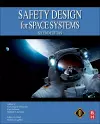
Safety Design for Space Systems
4 contributors - Hardback
£119.00
Tommaso Sgobba is Executive Director and Board Secretary of IAASS (International Association for the Advancement of Space Safety). Tommaso Sgobba has been IAASS first President in the period 2005-2013. Until June 2013 Tommaso Sgobba has been responsible for flight safety at the European Space Agency (ESA), including human-rated systems, spacecraft re-entries, space debris, use of nuclear power sources, and planetary protection. He joined the European Space Agency in 1989, after 13 years in the aeronautical industry. Initially he supported the developments of the Ariane 5 launcher, several earth observation and meteorological satellites, and the early phase of the European Hermes spaceplane. Later he became _Product Assurance and Safety Manager for all European manned missions on Shuttle, MIR station, and for the European research facilities of the International Space Station. He chaired for 10 years the ESA ISS Payload Safety Review Panel. He was also instrumental in setting up the ESA Re-entry Safety Review Panel. Tommaso Sgobba holds an M.S. in Aeronautical Engineering from the Polytechnic of Turin (Italy), where he was also professor of space system safety (1999-2001). He has published several articles and papers on space safety, and co-edited the text book “Safety Design for Space Systems, published in 2009 by Elsevier, that was also published later in Chinese. He was the Editor-in-Chief of the books “Safety Design for Space Operations (2013) and “Space Safety and Human Performance (2017) also published by Elsevier. He is Managing Editor of the Journal of Space Safety Engineering and member of the editorial board of the Space Safety Magazine. Tommaso Sgobba is the inventor (patent pending) of the R-DBAS (Re-entry, Direct Broadcasting Alert System), to alert the air traffic of falling fragments from uncontrolled space system re-entry. Tommaso Sgobba received the NASA recognition for outstanding contribution to the International Space Station in 2004, and the prestigious NASA Space Flight Awareness (SFA) Award in 2007. Dr. Gary Eugene Musgrave received his undergraduate training at Auburn University, where he received the Baccalaureate in Biological Sciences in 1969, and at the Georgia Institute of Technology, where he studied Electrical Engineering from 1971 until 1973. He received his graduate education at Auburn University, receiving the Master of Science in the field of Pharmacology/Toxicology from the School of Pharmacy in 1976, and the Doctor of Philosophy in the fields of Cardiovascular Physiology and Autonomic Neuropharmacology from the School of Veterinary Medicine in 1979. After completing his postdoctoral research, Dr. Musgrave was appointed Research Assistant Professor in the Department of Medicine at the Medical College of Virginia where he was Co-Investigator and the Engineering Project Director for a NASA sponsored investigation of the baroreflex regulation of blood pressure in astronauts during and after missions in space. This experiment ultimately was flown on the Spacelab “Space Life Sciences-1 mission. In 1982, Dr. Musgrave joined the NASA team at the Johnson Space Center in Houston, Texas, as an employee of the Management and Technical Services Company (MATSCO), a subsidiary of the General Electric Corporation, as the contractor manager for NASA’s Detailed Science Objective Program, where he was responsible for the development, certification, testing, and flight support for numerous items of medical hardware flown on various Space Shuttle missions. Dr. Musgrave retired from NASA during 2008 and presently resides in Tennessee, where he works as a consultant and educator. He is a member of the International Association for the Advancement of Space Safety, and its Academic Committee, and is Chief Editor of the 1st edition of Safety Design for Space Systems. Gary Johnson began his career in 1964 at NASA Johnson Space Center as a project engineering in the Power Distribution and Sequencing Section for subsystem support of the Apollo sequencer system. Following various roles and responsibilities, last being Associate Director for Technical, Safety and Mission Assurance Directorate, he retired from NASA in 2006. From March 2007 to June 2010 he was an SAIC IPAO Contract technical consultant on the Constellation Program Orion Crew Exploration Vehicle Standing Review Board for Safety, and from June 2007 to September 2012 he was an SAIC Safety & Mission Assurance Support Services Contract technical consultant for Apollo and Space Shuttle lessons learned training and Space Shuttle and International Space Station (ISS) S&MA Flight Safety Office assessments. As of October 2012, he has been an Aerospace Safety Consultant for J & P Technologies, supporting the SAIC Safety & Mission Support Engineering Services Contract to the NASA Johnson Space Center Safety & Mission Assurance Directorate, Flight Safety Office. Dr. Kezirian is a former Associate Technical Fellow for the Boeing Company, most recently supporting the Commercial Crew Program (Boeing CST-100 Starliner). He was a design analyst for the Nitrogen Oxygen Recharge System (NORS) for the International Space Station In support of the Space Shuttle Program, he was the Boeing Vehicle Safety Lead for the Endeavour Vehicle and the lead analyst for the Composite Overwrapped Pressure Vessel (COPV) safety design team. He has developed satellite designs and supported mission operations in the propulsion and attitude control departments at TRW Space and Technology Group (now Northrop Grumman) and Hughes Space and Communication (now Boeing). Previously, Dr. Kezirian was a spacecraft autonomy engineer for government communication and commercial satellite programs at Boeing and a propulsion engineer at TRW Space and Technology (now Northrop Grumman) in Southern California. Dr. Kezirian is currently an Adjunct Associate Professor at the University of Southern California where he leads a small research group and teaches the graduate-level space safety course in the Department of Astronautical Engineering. He is an Associate Fellow of the American Institute of Aeronautics and Astronautics (AIAA) and a member of the AIAA’s Space Operations Support Technical Committee at the national level. Dr. Kezirian holds PhD and M.S. degrees in Chemical Engineering from the Massachusetts Institute of Technology and B.S degree in Chemical Engineering from Brown University. Dr. Kezirian is the founding editor-in-chief of Elsevier’s Journal of Space Safety Engineering. He is the chairperson of the AIAA Aerospace Pressure Vessel Committee on Standards.